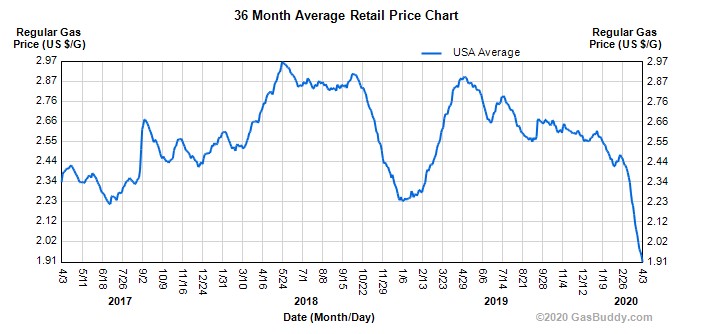Oil prices spiked this week on news that key producers — Saudi Arabia, Russia and perhaps the state of Texas — could arrange a coordinated cut in supply. But the defining story of oil in the age of global coronavirus is not supply, analysts say. It’s a historic plunge in demand that has pushed U.S. average gasoline prices to $1.91 a gallon.

Except in China, where virus-related travel restrictions are being lifted, most people in the world are not moving. Oil, of course, is for moving. Many analysts project that world demand for crude in April could plummet by 30%. That would be the worst dive ever — almost.
“We saw an equivalent drop from 1929 to 1934,” Philip Verleger, longtime energy economist and senior energy adviser in the Carter administration, said. “Crude prices went from $2 a barrel to 25 cents. A 90% drop.”
To avoid a repeat of that, oil producers are trying to respond. American oil and gas executives met at the White House Friday to discuss policy responses. And Monday, representatives of OPEC and Russia are expected to meet by video to consider joint supply cuts. But to many, discussions of oil supply are a sideshow.
“You know, the suppliers are sexy and the demand is boring,” Sarah Ladislaw, energy fellow and vice president at the Center for Strategic and International Studies. “But the reality is that there’s probably not a lot suppliers can do in terms of supply cuts, because the demand destruction is just so large.”
There’s probably not a lot suppliers can do … demand destruction is just so large.
Sarah Ladislaw, Center for Strategic and International Studies
Because demand has plunged spectacularly, the world’s oil is projected to run out of storage space in the next few months. Crude oil would physically have no place to go, forcing producers to stop pumping abruptly. Prices could collapse further. To avoid that scenario, the world’s largest oil suppliers are mulling unheard of supply cuts to match the historic destruction in demand.
“Russia, Saudi Arabia and the U.S. are producing something like 35 million barrels” per day, Per Magnus Nysveen, lead analyst and senior partner of Rystad Energy, said. “If they are cutting up to 15 million barrels [daily], they are cutting up to half their production. Extremely dramatic.”
They are trying to survive until a possible recovery in demand next year. Ladislaw, however, warns that would only happen if the virus is contained and people are and driving and flying again.
Related Stories
If you’re a member of your local public radio station, we thank you — because your support helps those stations keep programs like Marketplace on the air. But for Marketplace to continue to grow, we need additional investment from those who care most about what we do: superfans like you.
Your donation — as little as $5 — helps us create more content that matters to you and your community, and to reach more people where they are – whether that’s radio, podcasts or online.
When you contribute directly to Marketplace, you become a partner in that mission: someone who understands that when we all get smarter, everybody wins.
"oil" - Google News
April 04, 2020 at 04:55AM
https://ift.tt/3aJ3TCG
“Suppliers are sexy,” but the real oil collapse story is demand - Marketplace
"oil" - Google News
https://ift.tt/2PqPpxF
Shoes Man Tutorial
Pos News Update
Meme Update
Korean Entertainment News
Japan News Update
Bagikan Berita Ini
















0 Response to "“Suppliers are sexy,” but the real oil collapse story is demand - Marketplace"
Post a Comment